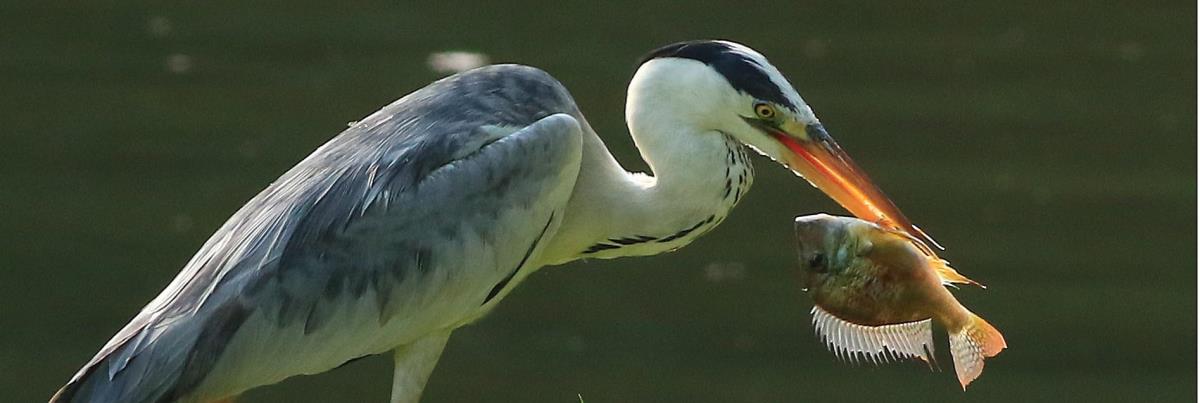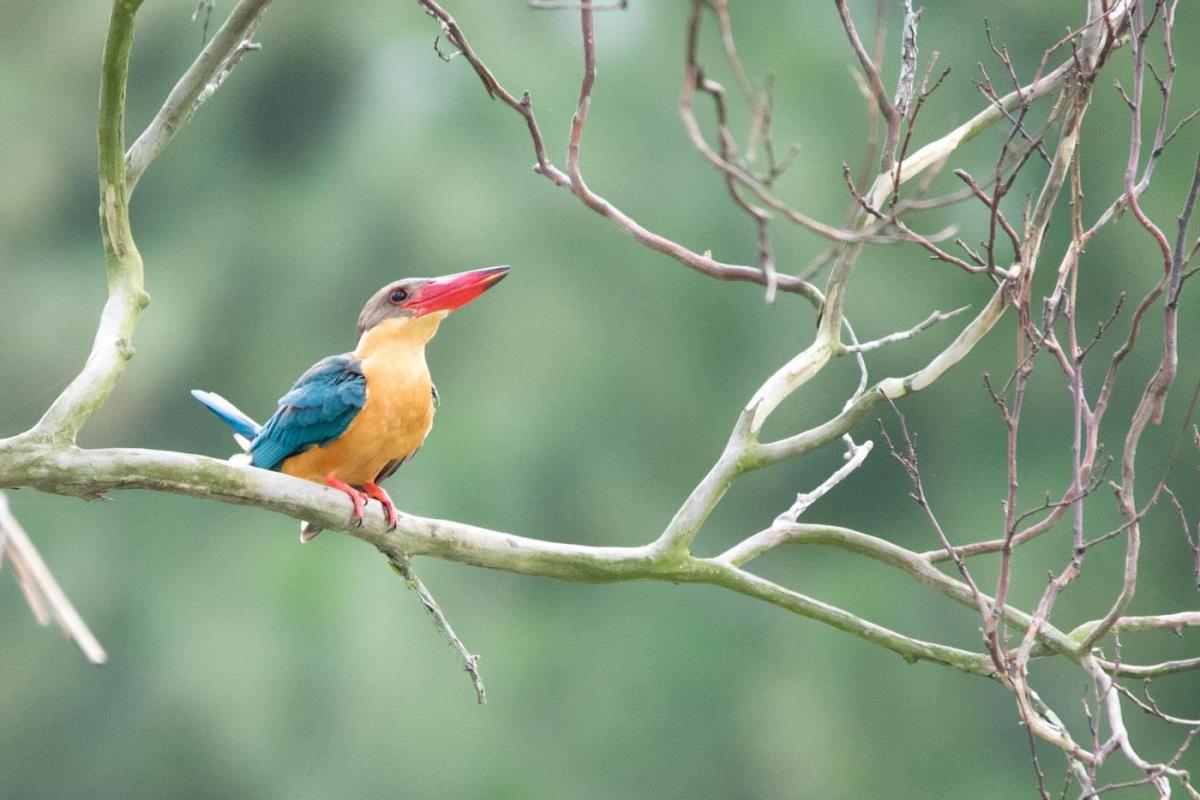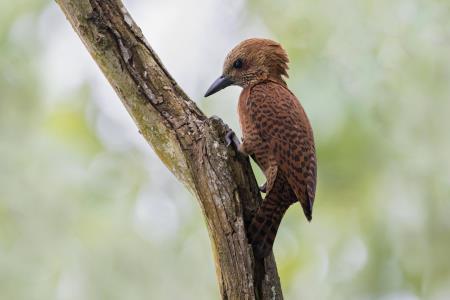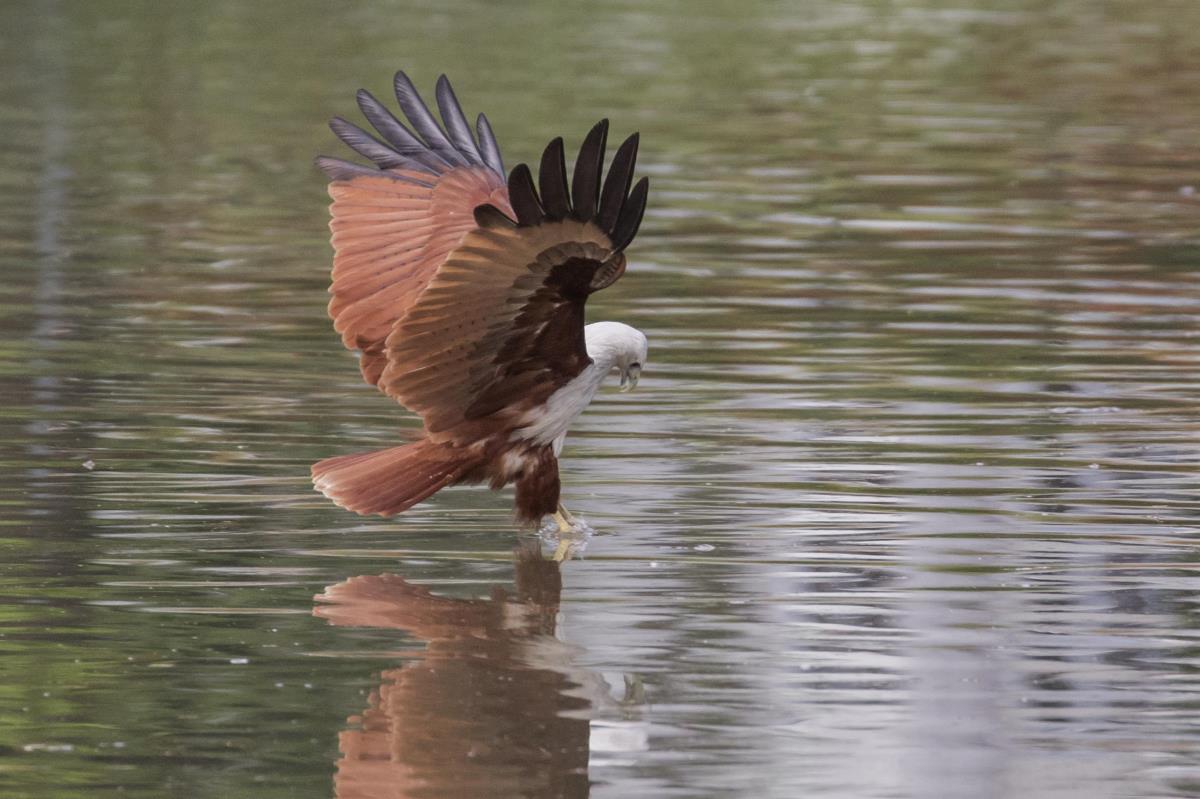Waterbirds of Jurong Lake Gardens
Waterbirds refer to birds that live on or around water. Many species have specialised adaptations like webbed feet, long legs and serrated bills for life in the wetlands. Waterbirds encompass many bird families including herons and egrets, shorebirds, ducks and rails to name a few. Listed here are some of the more commonly seen waterbirds in Jurong Lake Gardens.
Herons, Bitterns and Egrets
A varied group of birds found in both freshwater and coastal wetlands, they are carnivores that feed on a variety of aquatic prey and small animals. They differ from storks and cranes in their curved “S” shaped necks, which are retracted completely when flying.
Grey Heron
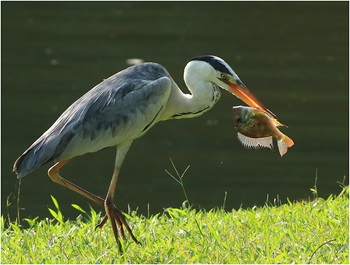 Photo credit: Ong Chwee Sia Photo credit: Ong Chwee Sia |
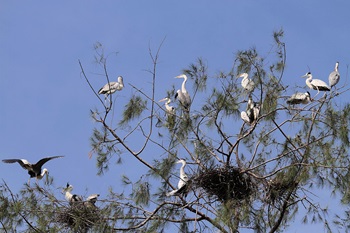 A heronry on a Casuarina Tree at Japanese Garden. Photo credit: Perlyn Chng A heronry on a Casuarina Tree at Japanese Garden. Photo credit: Perlyn Chng |
| Scientific name: | Ardea cinerea |
| Common name: | Grey Heron |
| Family: | Ardeidae |
 100 cm 100 cm |

The tallest and most commonly seen heron in Jurong Lake Gardens, the Grey Heron has a wingspan of 2 m. It has mostly white plumage with a black stripe on the head and black streaks down the centre of its neck. Its bill is dull yellow. You can observe a nesting colony on the Casuarina trees at Japanese Garden.

Diet and Behaviour
They feed on fish, amphibians, small mammals and insects. They are often observed perched on trees or the banks of large water bodies.
Where are they found?
This species is commonly observed in a variety of freshwater and coastal wetlands across Singapore. Nesting colonies can be found at Pasir Ris Park and Japanese Garden. They are widely distributed globally and can be found in Europe, Africa and Asia.
Did you know?
A nesting colony of herons is known as a heronry.

It is classified as nationally endangered, but the local population has been increasing in recent years.
Purple Heron
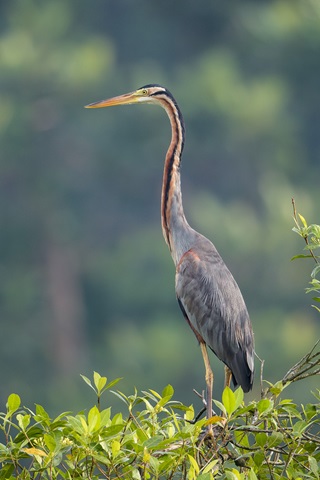 Photo credit: Francis Yap Photo credit: Francis Yap |
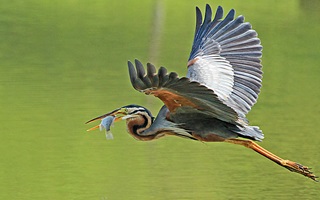 Photo credit: Ong Chwee Sia Photo credit: Ong Chwee Sia |
| Scientific name: | Ardea pupurea |
| Common name: | Purple Heron |
| Family: | Ardeidae |
 78–90 cm 78–90 cm |

The adult Purple Heron has a black crown with distinct black lines running down the sides of its face and neck. It has grey upperparts, a reddish-brown neck, and dark chestnut underparts. The bill and legs are yellowish orange. The juvenile is largely brown and lacks the bold black lines along its head and neck.

Diet and Behaviour
The Purple Heron feeds on a wide variety of prey including fish, frogs and other small animals. Like many herons, it stands motionless in shallow water, waiting for the opportunity to impale its prey with its sharp beak. It is shy and often conceals itself in dense vegetation.
Where are they found?
It is an uncommon resident that is usually observed in well-vegetated freshwater wetlands in Singapore including Kranji Marshes, Bishan-Ang Mo Kio Park and Jurong Lake Gardens. The Purple Heron is also found from Africa and Europe to the Indian subcontinent and Southeast Asia.
Striated Heron
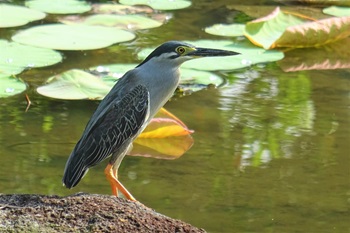 Photo credit: Ruth Tan (NParks) Photo credit: Ruth Tan (NParks) |
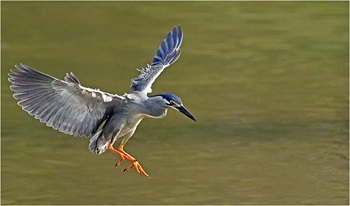 In flight. Photo credit: Ong Chwee Sia In flight. Photo credit: Ong Chwee Sia |
| Scientific name: | Butorides striata |
| Common name: | Striated Heron |
| Family: | Ardeidae |
 40–48 cm 40–48 cm |

The Striated Heron has bluish grey plumage with a black cap on its head and a dark bill. Its wings are black with buff edges, giving it the appearance of white scales. Its legs are glossy orange during breeding season, but olive grey or yellowish green otherwise. Compared to the Grey Heron it is smaller and stockier.

Diet and Behaviour
Like most herons, aquatic prey like fish form a large part of their diet. They are solitary and are often seen perching along the banks of water bodies.
Where are they found?
This is the most adaptable and commonly encountered small heron in Singapore. They can be found in all freshwater and coastal wetlands, including urban canals.
Did you know?
Striated Herons are known to use pieces of bread as bait when hunting fish.
Black-crowned Night Heron
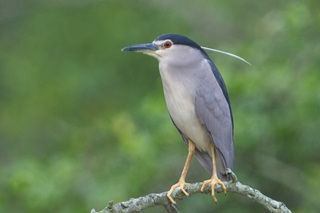 Photo credit: Francis Yap Photo credit: Francis Yap |
| Scientific name: | Nycticorax nycticorax |
| Common name: | Black-crowned Night Heron |
| Family: | Ardeidae |
 58–65 cm 58–65 cm |

Both adults and juveniles have distinctive red eyes. Adults have a diagnostic black crown, bill and back which contrast with their white underparts. Juveniles have dull grey plumage with pale spots.

Diet and Behaviour
These birds are primarily nocturnal. Their diet includes small fish, crustaceans, frogs and large insects. During the day, they rest in dense trees close to water.
Where are they found?
These shy birds are found in larger freshwater and coastal wetlands across Singapore. Globally, they have a wide distribution ranging from Europe and Africa to most of Southeast Asia.
Did you know?
Its scientific name Nycticorax means “night raven” in Latin and reflects the heron’s nocturnal habits and distinctive call.

This species is nationally threatened due to the lack of suitable nesting habitat.
Chinese Pond Heron
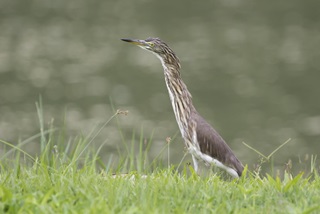 Non-breeding plumage. Photo credit: Loke Peng Fai Non-breeding plumage. Photo credit: Loke Peng Fai |
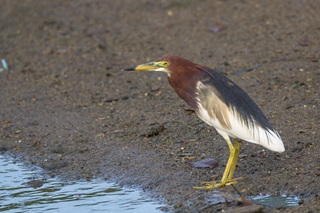 Breeding plumage. Photo credit: Francis Yap Breeding plumage. Photo credit: Francis Yap |
| Scientific name: | Ardeola bacchus |
| Common name: | Chinese Pond Heron |
| Family: | Ardeidae |
 46 cm 46 cm |

It is indistinguishable from other pond herons like the Javan Pond Heron and Indian Pond Heron during non-breeding season. However, its breeding plumage is distinctive with a maroon head, neck and upper breast, white underparts and a black back.

Diet and Behaviour
They are usually observed in flooded fields and freshwater marshes where they forage on a variety of small animals.
Where are they found?
This is a migratory species which breeds in China and migrates to Southeast Asia during the northern winter. They are usually found in freshwater wetlands and flooded fields such as Bishan-Ang Mo Kio Park and Lorong Halus. They are frequently observed in the field between Chinese Garden MRT station and Jurong Lake Gardens.
Yellow Bittern
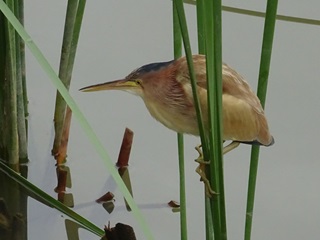 Male. Photo credit: Woo Mun Shih Male. Photo credit: Woo Mun Shih |
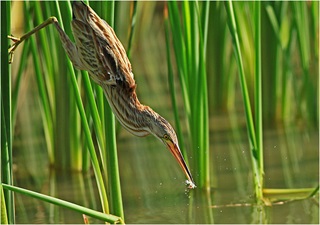 Female. Photo credit: Ong Chwee Sia Female. Photo credit: Ong Chwee Sia |
| Scientific name: | Ixobrychus sinensis |
| Common name: | Yellow Bittern |
| Family: | Ardeidae |
 38 cm 38 cm |

This species exhibits sexual dimorphism, meaning the males and females look different. Males have a black crown, while the females are brown throughout. The striking contrast between their black flight feathers and yellowish plumage makes them easy to identify in flight.

Diet and Behaviour
It is often seen perched motionless in reed beds waiting to ambush passing prey. They feed on fish, insects and crustaceans.
Where are they found?
It is found in freshwater wetlands including marshes and well-vegetated ponds. It is regularly seen at Gardens by the Bay, Kranji Marshes and Jurong Lake Gardens, among other sites.
Did you know?
Every year between October to March, Singapore’s resident Yellow Bittern population is joined by migratory populations that breed in China and migrate to Southeast Asia to escape the northern winter.
Eastern Cattle Egret
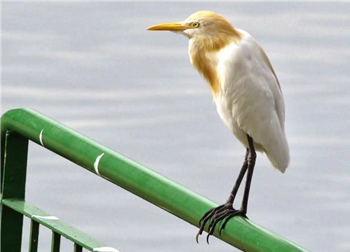 Photo credit: Perlyn Chng Photo credit: Perlyn Chng |
| Scientific name: | Bubulcus coromandus |
| Common name: | Eastern Cattle Egret |
| Family: | Ardeidae |
 48–53 cm 48–53 cm |

While it looks similar to other white egret species, it tends to be smaller, stockier and sports a shorter and thicker neck, with a short yellowish bill and black legs. During breeding season, they develop golden brown plumes.

Diet and Behaviour
As their name suggests, they are usually found in flooded fields in close proximity to livestock. They forage on small animals flushed out by moving livestock and also feed on parasites found on the livestock.
Where are they found?
They are found across much of the world’s tropical regions. In Singapore, it is a migratory species and flocks are regularly seen in flooded fields during the northern winter.
Did you know?
In Singapore, Eastern Cattle Egrets have adapted to feasting on small animals disturbed by grass cutters and lawnmowers!
Little Egret
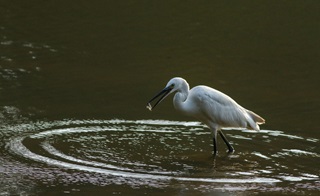 Photo credit: Ong Chwee Sia Photo credit: Ong Chwee Sia |
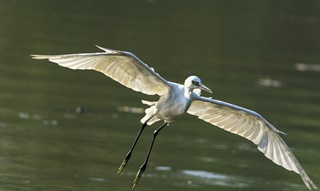 Photo credit: Ong Chwee Sia Photo credit: Ong Chwee Sia |
| Scientific name: | Egretta garzetta |
| Common name: | Little Egret |
| Family: | Ardeidae |
 55–65 cm 55–65 cm |

The Little Egret has a uniformly white plumage with black legs, green toes, and a blackish beak. During the breeding season, the adult develops white plumes behind its head.

Diet and Behaviour
The Little Egret is gregarious and is often found in flocks. It employs a variety of methods to catch fish for food, such as disturbing small fish by shuffling its feet in water or using a wait-and-ambush strategy.
Where are they found?
It is a common migrant in Singapore, and can be observed in a variety of wetlands from urban canals to coastal mudflats. It breeds in countries such as China, Korea and Japan.
Rails
Rails are a large family of ground-dwelling birds associated with wetlands. Most species are shy and prefer to run at the first sign of danger. Even so, many species undertake long distance migrations from their breeding grounds in northern Asia to spend winter in Southeast Asia’s wetlands.
White-breasted Waterhen
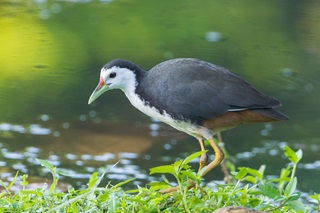 Photo credit: Francis Yap Photo credit: Francis Yap |
| Scientific name: | Amaurornis phoenicurus |
| Common name: | White-breasted Waterhen |
| Family: | Rallidae |
 28-36 cm 28-36 cm |

It is easily identified by its contrasting black upperparts and white underparts with a chocolate brown vent.

Diet and Behaviour
These omnivorous birds are often observed foraging at the edge of freshwater wetlands close to dense vegetation. When threatened, they make a dash for the nearest cover.
Where are they found?
This bird is commonly encountered in wetlands across Singapore and has adapted to life in urban ponds as well. It is distributed across the Indian Subcontinent and Southeast Asia.
Did you know?
Their chicks are flightless and have a uniformly black body!
Shorebirds
Common Sandpiper
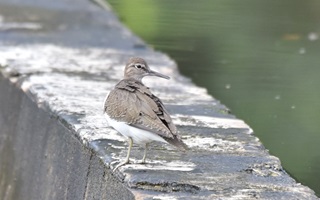 Photo credit: Nicholas Kee (NParks) Photo credit: Nicholas Kee (NParks) |
| Scientific name: | Actitis hypoleucos |
| Common name: | Common Sandpiper |
| Family: | Scolopacidae |
 20cm 20cm |

The Common Sandpiper has grey-brown upperparts, white underparts, and yellowish-brown legs.

Diet and Behaviour
The Common Sandpiper is solitary and has a habit of bobbing its head up and down while walking, and flicking its wings in flight. It is often observed feeding on small invertebrates along the banks of canals and artificial water bodies like reservoirs.
Where are they found?
It is the most commonly encountered shorebird in Singapore and can be observed in both freshwater and coastal wetlands. It breeds across many European countries such as Russia.
Banner: Grey Heron. Photo credit: Ong Chwee Sia


